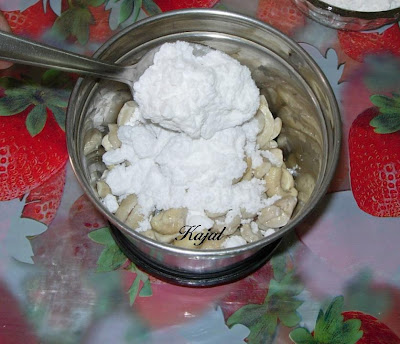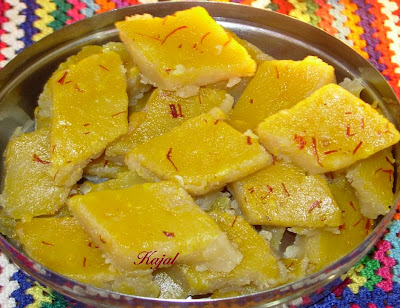

O! Jingle bells, jingle bells, |

Dates or Khajoor are valuable as medicine for their tonic effect. Being easily digested, they are very useful for supplying energy and repairing waste. Milk in which clean and fresh dates have been boiled is a very nourishing and restorative drink to children and adults alike, especially during convalescence.

4-5 pieces of khajoor (dates)
150 ml simple milk
3-4 kaju (cashews)
4-5 almond
1-tbsp sugar
Step 1: Deseed the khajoor and cut dry- fruit in to small pieces.

Step 3: Soak khajoor for half an hour in milk.
Step 4: In a blender put khajoor and quarter portion of milk and blend it to a thick cream.
One day, One girl was wandering in the forest thinking about and

missing his beloved.
Santa was looking down upon the earth looking for a soul to torment.
He saw girl wandering alone in the forest and flew down to meet him.
Santa said: “Why you, I have been looking for you”.A startled Girl asked: “What do you want?”
Santa said: “What do I want?, Girl, please, I have a wonderful offer for YOU”.
Girl replied: “Thanks, but I am not interested”.
Santa said: “Why Girl, you haven’t even heard what I have to offer. I could make you very wealthy!!”

Santa said: “Yes, I will make you quite wealthy! You will be rich beyond your dreams!”
Girl replied: “Excuse me if I sound suspicious, but there wouldn’t happen to be a catch?”
Santa said: “Girl I am offering you so much!! All you have to do is give up your love for you and I will make you rich beyond your dreams.”

Santa saw the smile and said: “See Girl, I knew you would like my offer.”
Girl smile broadened and she replied: “You don’t understand. Santa, I am Not interested in your offer. With my friend LOVE, I ALREADY AM rich Girl beyond my dreams.”





































 The idea behind the Festival of Lights comes from various versions of an ancient Hindu story. In northern India, the tale tells about the holy Lord Rama's return from a twelve-year exile and the celebration by the people for their beloved hero. The pious and rejoicing people decorated their city with candles and lights to welcome him back. In southern India, the story talks of the Goddess Durga's triumph over the evil demon Narakasura. This triumph of good over evil brought back the light of knowledge and truth to mankind.
The idea behind the Festival of Lights comes from various versions of an ancient Hindu story. In northern India, the tale tells about the holy Lord Rama's return from a twelve-year exile and the celebration by the people for their beloved hero. The pious and rejoicing people decorated their city with candles and lights to welcome him back. In southern India, the story talks of the Goddess Durga's triumph over the evil demon Narakasura. This triumph of good over evil brought back the light of knowledge and truth to mankind. 






 Ingredients:
Ingredients: 
 Method:
Method: Step 2: Soak the saffron strings in one tbsp water and keep aside.
Step 2: Soak the saffron strings in one tbsp water and keep aside.  Step 3: After one hour drain the water and spread it on the paper towel.
Step 3: After one hour drain the water and spread it on the paper towel. Step 4: In a mixture bowl take sugar and then cashew.
Step 4: In a mixture bowl take sugar and then cashew. 
 Step 5: Crush it to powder.
Step 5: Crush it to powder. Step 7: Grind it in mixture until you get powder like consistency.
Step 7: Grind it in mixture until you get powder like consistency.  Step 8: Heat one tbsp ghee in pan or kadhai.
Step 8: Heat one tbsp ghee in pan or kadhai.  Step 9: Add the mixture in it.
Step 9: Add the mixture in it.  Step 10: Stirring continuously.
Step 10: Stirring continuously.  Step 11: Stirring until it get soft bubbles formed in it. It will take 9-10 minutes approximately.
Step 11: Stirring until it get soft bubbles formed in it. It will take 9-10 minutes approximately.
 Step 13: Pure the saffron water over it and add some of the strings for decorate the kaju katli. If you like then apply Varak (pure silver foil). Many jains do not use varak.
Step 13: Pure the saffron water over it and add some of the strings for decorate the kaju katli. If you like then apply Varak (pure silver foil). Many jains do not use varak.  Step 14: Let it cool for half an hour and after that cut it in diamond shape.
Step 14: Let it cool for half an hour and after that cut it in diamond shape. 
 Step 15: Store in container.
Step 15: Store in container. 




 Step 2: Add the sugar powder in it. If you like then add more sugar here as you add 250 gm sugar is best test but we use less sugar in our sweet.
Step 2: Add the sugar powder in it. If you like then add more sugar here as you add 250 gm sugar is best test but we use less sugar in our sweet. Step 3: Add the milk malai in it. Mix all these three ingredient properly then start the flame of gas.
Step 3: Add the milk malai in it. Mix all these three ingredient properly then start the flame of gas.
 Step 4: Sauté it well in medium flame.
Step 4: Sauté it well in medium flame. Step 5: Stirring continuously for 10 to 12 minutes. When mixer becomes thick and it doesn’t contains the water part then turn the flame in low. Mix the cardamom powder.
Step 5: Stirring continuously for 10 to 12 minutes. When mixer becomes thick and it doesn’t contains the water part then turn the flame in low. Mix the cardamom powder.  Step 6: Add grated mava when the mixer thickens and becomes dry and firm (like a fudge consistency) but still soft.
Step 6: Add grated mava when the mixer thickens and becomes dry and firm (like a fudge consistency) but still soft. 
 Step 7: Stir the mixer in low flame for 4-5 minutes.
Step 7: Stir the mixer in low flame for 4-5 minutes. Step 9: Pour into a ghee-smeared plate.
Step 9: Pour into a ghee-smeared plate. Step 11: Cut it into square pieces. (Decorate with varakh (pure silver foil) if you like.)
Step 11: Cut it into square pieces. (Decorate with varakh (pure silver foil) if you like.) Step 12: After it is completely cool, put it in the refrigerator so that it sets in firmly and doesn’t break.
Step 12: After it is completely cool, put it in the refrigerator so that it sets in firmly and doesn’t break. Step 13: Remove after 6-7 hours. Coconut burfi is ready to eat.
Step 13: Remove after 6-7 hours. Coconut burfi is ready to eat.

 Step 2: Melt the chocolate in microwave or over a pan of hot water.
Step 2: Melt the chocolate in microwave or over a pan of hot water.
 Step 3: Pour the chocolate mixer over the coconut burfi.
Step 3: Pour the chocolate mixer over the coconut burfi. Step 4: Let cool for about 20 minutes until burfi is just look warm. Cut into square or diamond shape with knife. Don’t remove from the plate.
Step 4: Let cool for about 20 minutes until burfi is just look warm. Cut into square or diamond shape with knife. Don’t remove from the plate. Step 5: Put this plate into refrigerator for 2-3 hours so chocolate layer is becomes hard.
Step 5: Put this plate into refrigerator for 2-3 hours so chocolate layer is becomes hard. Step 7: Store in container and refrigerate for days.
Step 7: Store in container and refrigerate for days.

